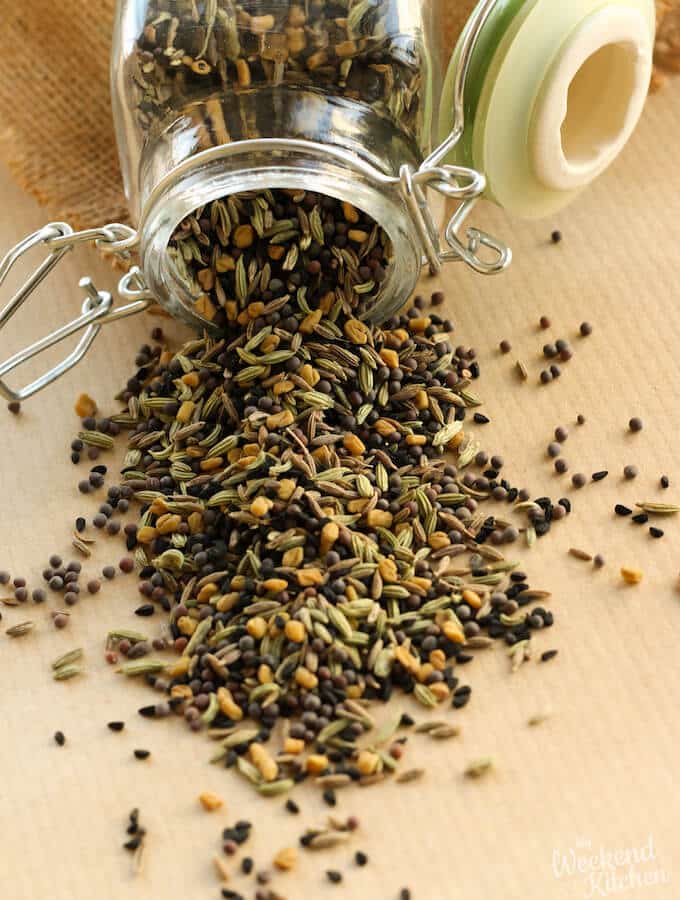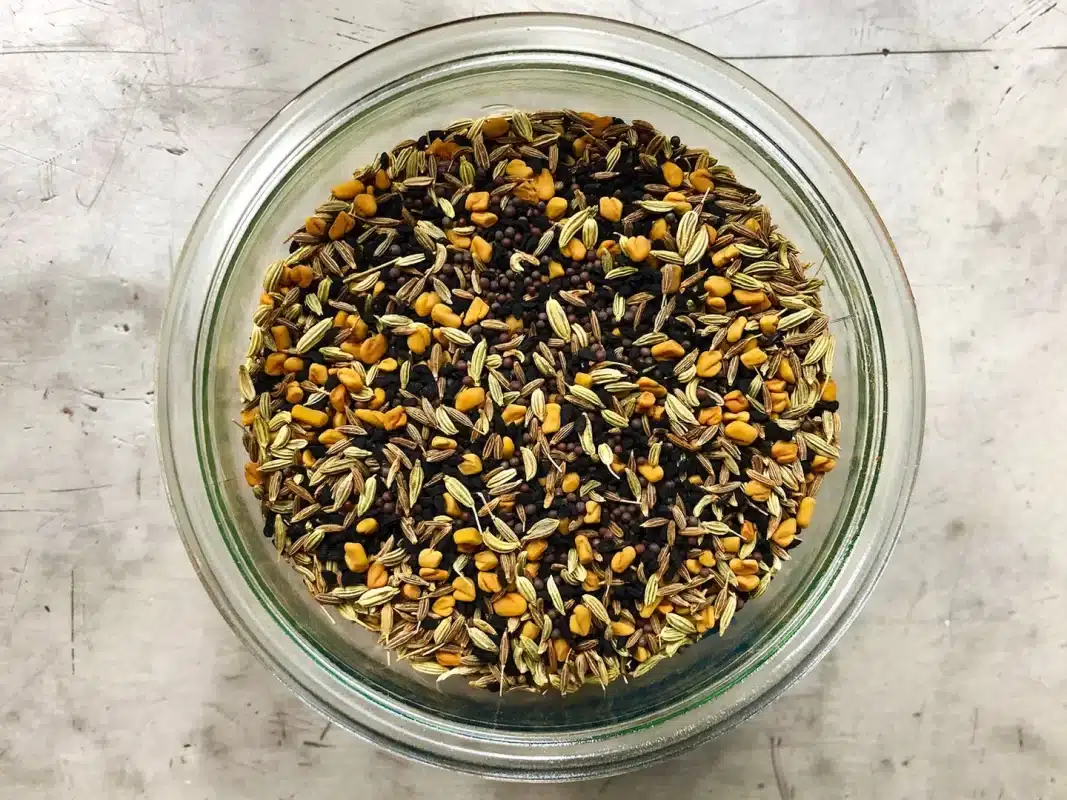Blog
Panch phoron vs. garam masala?

In the realm of spices, Panch Phoron and Garam Masala stand out as quintessential blends that define the aromatic landscapes of Indian cuisine. Despite their common usage in traditional dishes, these spice blends offer distinct flavor profiles and culinary applications. In this exploration, we delve into the nuances of Panch Phoron and Garam Masala, unraveling their ingredients, flavors, and roles in culinary creations.
Panch Phoron: A Symphony of Five Spices
Panch Phoron, translating to “five spices” in Bengali, is a unique blend that encapsulates the essence of Eastern Indian cooking. Comprising equal parts of fenugreek seeds, nigella seeds, cumin seeds, black mustard seeds, and fennel seeds, Panch Phoron offers a harmonious combination of flavors and aromas. Each spice contributes its distinct character, from the bitterness of fenugreek seeds to the pungency of black mustard seeds and the sweetness of fennel seeds. Used whole and tempered in hot oil or ghee, Panch Phoron releases its aromatic oils, infusing dishes with a fragrant bouquet that is both comforting and captivating.
Garam Masala: The Warmth of Spices
Garam Masala, meaning “hot spice blend” in Hindi, is a cornerstone of North Indian cuisine, renowned for its warm and robust flavors. Unlike Panch Phoron, which contains whole spices, Garam Masala is a ground spice blend that combines a variety of aromatic ingredients. Common components include cinnamon, cardamom, cloves, black peppercorns, and nutmeg, among others. The spices are toasted and ground to create a fine powder that adds depth and complexity to dishes. Garam Masala offers a rich tapestry of flavors, with hints of sweetness, warmth, and earthiness that linger on the palate.
Comparing Flavor Profiles
The flavor profiles of Panch Phoron and Garam Masala reflect the culinary traditions of their respective regions. Panch Phoron’s blend of whole spices imparts a distinct freshness and texture to dishes, with each spice contributing its unique nuances. The bitterness of fenugreek seeds adds depth, while the nuttiness of nigella seeds and the warmth of cumin seeds create a flavorful base. The sharpness of black mustard seeds and the sweet aroma of fennel seeds complete the ensemble, offering a balanced and nuanced taste experience.
In contrast, Garam Masala’s ground spice blend provides a concentrated burst of flavors, with the aromatic notes of cinnamon and cardamom taking center stage. The spiciness of black peppercorns and the warmth of cloves add layers of complexity, while nutmeg lends a subtle sweetness to the mix. Garam Masala’s flavor profile is bold and intense, with a lingering warmth that elevates both savory and sweet dishes.
Culinary Applications
Panch Phoron and Garam Masala play distinct roles in Indian cuisine, each contributing to a wide range of dishes. Panch Phoron is commonly used in Eastern Indian cooking, particularly in Bengali and Assamese cuisines. It enhances the flavor of vegetable curries, lentil stews, fish preparations, and meat dishes, infusing them with its aromatic essence. The whole spices in Panch Phoron release their flavors slowly during cooking, creating a nuanced taste experience that evolves with each bite.
On the other hand, Garam Masala is a staple in North Indian cooking, where it is used to season a variety of dishes, including curries, biryanis, and kebabs. Its ground form allows for easy incorporation into recipes, providing an instant burst of flavor and warmth. Garam Masala is often added towards the end of the cooking process or sprinkled as a finishing touch to enhance the overall taste and aroma of the dish.
Versatility and Adaptability
While Panch Phoron and Garam Masala are deeply rooted in their respective regional cuisines, they are not limited to traditional dishes. Both spice blends offer versatility and adaptability, allowing them to be incorporated into a wide range of culinary creations. Panch Phoron’s whole spices can be used to temper oils, create marinades, or add depth to soups and stews. Similarly, Garam Masala’s ground form lends itself well to spice rubs, sauces, and even desserts, infusing them with its signature warmth and complexity.
Nutritional Benefits
Both Panch Phoron and Garam Masala offer a host of nutritional benefits derived from their aromatic ingredients. Fenugreek seeds in Panch Phoron are rich in fiber and antioxidants, while cumin seeds aid digestion and black mustard seeds contain essential minerals. Similarly, the spices in Garam Masala, such as cinnamon and cloves, are known for their anti-inflammatory properties, while cardamom and nutmeg offer digestive benefits. Incorporating these spice blends into the diet can enhance overall health and well-being.
Celebrating Spice Diversity
In conclusion, Panch Phoron and Garam Masala represent the rich tapestry of flavors and aromas that define Indian cuisine. While Panch Phoron offers a fresh and textured taste experience with its whole spices, Garam Masala provides a concentrated burst of warmth and intensity with its ground blend. Both spice blends play integral roles in their respective culinary traditions, enriching dishes with their unique characteristics. Whether used in traditional recipes or innovative creations, Panch Phoron and Garam Masala celebrate the diversity and complexity of spices in Indian cooking, inviting culinary exploration and appreciation.
FAQ:
- What is Panch Phoron, and how is it used in cooking? Panch Phoron is a Bengali spice blend composed of equal parts fenugreek seeds, nigella seeds, cumin seeds, black mustard seeds, and fennel seeds. It is typically used whole and tempered in hot oil or ghee at the beginning of the cooking process to release its flavors.
- What is Garam Masala, and how does it differ from Panch Phoron? Garam Masala is a North Indian spice blend made from ground cinnamon, cardamom, cloves, black peppercorns, and nutmeg. Unlike Panch Phoron, Garam Masala is in powder form and imparts a concentrated burst of warm, intense flavors.
- Can Panch Phoron and Garam Masala be used interchangeably? While both spice blends offer unique flavor profiles, they serve different culinary purposes. Panch Phoron is typically used in Eastern Indian dishes, while Garam Masala is common in North Indian cuisine. However, creative cooks may experiment with them in fusion dishes.
- What dishes are best complemented by Panch Phoron? Panch Phoron enhances the flavors of vegetable curries, lentil stews, fish preparations, and meat dishes in Bengali and Assamese cuisines. Its whole spices release flavors slowly during cooking, creating a nuanced taste experience.
- In which dishes is Garam Masala commonly used? Garam Masala is a versatile spice blend used in a variety of North Indian dishes, including curries, biryanis, kebabs, and savory snacks. It adds a rich tapestry of warm and intense flavors to both sweet and savory recipes.
- Can I make Panch Phoron or Garam Masala at home? Yes, both spice blends can be made at home. Panch Phoron requires equal parts of fenugreek seeds, nigella seeds, cumin seeds, black mustard seeds, and fennel seeds. Garam Masala involves toasting and grinding cinnamon, cardamom, cloves, black peppercorns, and nutmeg.
- Are Panch Phoron and Garam Masala gluten-free? Yes, both Panch Phoron and Garam Masala are naturally gluten-free as they consist of whole or ground spices without added ingredients.
- What are the health benefits associated with Panch Phoron and Garam Masala? Fenugreek seeds in Panch Phoron are rich in fiber and antioxidants, aiding digestion. Garam Masala spices like cinnamon and cloves have anti-inflammatory properties, while cardamom and nutmeg offer digestive benefits.
- Can Panch Phoron and Garam Masala be used in international cuisines? Yes, both spice blends offer versatility and can be incorporated into a wide range of international dishes for a unique flavor profile. Panch Phoron’s whole spices and Garam Masala’s ground form adapt well to various culinary creations.
- How should Panch Phoron and Garam Masala be stored for freshness? To maintain freshness, store both Panch Phoron and Garam Masala in airtight containers away from heat and sunlight. Whole spices in Panch Phoron may retain flavors longer than ground Garam Masala, so they have different storage considerations.



